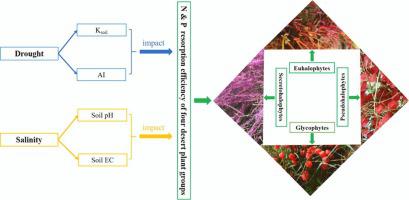Ecological Indicators ( IF 7.0 ) Pub Date : 2021-02-13 , DOI: 10.1016/j.ecolind.2021.107488 Yan Luo , Yue Chen , Qingwen Peng , Kaihui Li , Anwar Mohammat , Wenxuan Han

|
Nutrient resorption efficiency (NuRE), an important plant functional trait, is closely related to plant nutrient utilization and biogeochemical cycling. Under severe aridity and salinity stress, plants developed various strategies to adapt to these adverse conditions after long-term structural and functional evolution in desert ecosystems. However, the impact of arid environment on plant nutrient resorption remains uncertain for desert halophytes. Here we compared the nitrogen and phosphorus resorption efficiency (NRE and PRE) among four desert plant groups (i.e., euhalophytes, secretohalophytes, pseudohalophytes and glycophytes) and analyzed the responses of NuRE to drought and saline indicators within and across the four plant groups. Our results demonstrated that the NRE and PRE of all desert plants were averagely 52.8% and 57.1%, respectively. Pseudohalophytes had significantly higher NRE (59.9%) and glycophytes had significantly lower PRE (53.2%) than the other groups. Besides, the relative resorption efficiencies (NRE − PRE) were significantly lower than zero for euhalophytes, secretohalophytes, and overall plants, but non-significantly different from zero for pseudohalophytes and glycophytes, suggesting that euhalophytes and secretohalophytes were generally P-limited: they tend to resorb more P than N from senescing leaves; but pseudohalophytes and glycophytes were both N- and P-limited: they resorb N and P in a balanced way (the relative resorption hypothesis). NuRE of the three halophytic groups responded to drought and saline stress in a generally consistent way: both NRE and PRE significantly increased with increasing water-stress (lower soil water stress coefficient (Ksoil) and aridity index (AI)) and salinity-stress (higher soil pH and electrical conductivity (EC)), although the relationships between PRE of euhalophytes and these four indicators, and between PRE of the three halophytic groups and soil EC, were non-significant. By contrary, NRE of the glycophytes showed a non-significant relation with water stress indicators (Ksoil) and soil EC. Overall, the patterns of NuRE in desert plants with different salt propensity suggest the evolutionary divergence (halophytes vs glycophytes) and convergence (euhalophytes, secretohalophytes, and pseudohalophytes) strategies in response to salinity and water stress. These findings provide a new perspective for understanding the nutrient resorption strategies of desert plants, and may also help better predict the nutrients biogeochemical cycling in desert ecosystem under global climate changes.
中文翻译:

干旱和盐胁迫对不同盐度沙漠植物的氮和磷吸收
营养吸收效率(NuRE)是植物重要的功能性状,与植物养分利用和生物地球化学循环密切相关。在严重的干旱和盐碱胁迫下,植物在沙漠生态系统中进行了长期的结构和功能演变后,制定了各种策略来适应这些不利条件。然而,干旱环境对沙漠盐生植物的植物养分吸收的影响仍然不确定。在这里,我们比较了四个荒漠植物群(即,沙漠植物)的氮和磷吸收效率(NRE和PRE),真盐,分泌盐,假盐和糖植物),并分析了四个植物群内和整个植物对NuRE对干旱和盐分指标的响应。我们的结果表明,所有荒漠植物的NRE和PRE分别平均为52.8%和57.1%。假盐生植物的NRE(59.9%)显着高于其他组,而糖类植物的PRE(53.2%)显着低于其他组。此外,真盐,分泌盐和植物的相对吸收效率(NRE-PRE)显着低于零,而假盐和糖植物的相对吸收效率与零没有显着差异,这表明真盐和分泌盐通常受磷限制:它们倾向于从衰老的叶片中吸收比氮更多的磷;但假盐生植物和糖生植物均受N和P限制:它们以平衡的方式吸收氮和磷(相对吸收假设)。三个盐生植物群的NuRE对干旱和盐胁迫的响应大致一致:NRE和PRE均随着水分胁迫的增加而显着增加(较低的土壤水分胁迫系数(K泥),干旱指数(AI)和盐度应力(较高的土壤pH和电导率(EC)),尽管真盐生植物的PRE与这四个指标之间的关系,以及三个盐生植物群的PRE与土壤EC之间的关系均不明确-重大。相反,糖类植物的NRE与水分胁迫指标(Ksoil)和土壤EC无关。总体而言,具有不同盐分倾向的沙漠植物中的NuRE模式表明,响应盐度和水分胁迫,进化趋异(盐生植物与糖生植物)和趋同(真盐植物,分泌盐和拟盐植物)策略。这些发现为了解沙漠植物的养分吸收策略提供了新的视角,











































 京公网安备 11010802027423号
京公网安备 11010802027423号